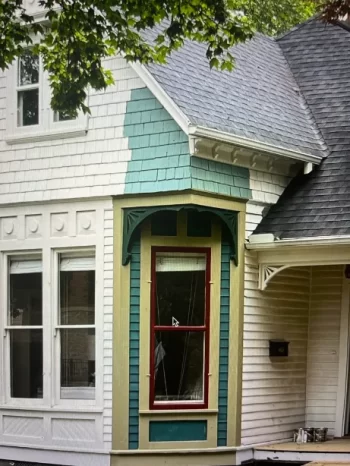Painting your fence in Arkansas is not just about enhancing its appearance; it is also crucial for protecting the wood from the specific climate and environmental factors in the region. By properly maintaining your fence, you can extend its lifespan and maintain its structural integrity. However, there are several common mistakes that people make during the painting or staining process that can negatively impact the results. In this article, we will explore these mistakes and provide valuable insights on how to avoid them, ensuring a beautiful and long-lasting finish for your fence.
Why is painting or staining a fence substantial in Arkansas?
In Arkansas, the weather conditions can be challenging for wooden fences. Regular exposure to sunlight, high humidity levels, and occasional heavy rainfall can cause the wood to warp, crack, or deteriorate. Painting or staining your fence acts as a protective barrier against these elements, preventing moisture penetration, UV damage, and fungal growth, ultimately prolonging its lifespan.
What are the specific climate and environmental factors in Arkansas that can affect the condition of a fence?
Arkansas experiences a humid subtropical climate with hot summers and mild winters. The high humidity levels, combined with temperature fluctuations and occasional heavy rain, can lead to wood expansion and contraction, causing the fence to become more susceptible to damage. Additionally, exposure to UV rays can result in fading, discoloration, and degradation of the wood if not properly protected.
What steps should be taken to clean and prepare the fence surface properly?
Properly cleaning and preparing the fence surface is crucial before applying paint or stain. Start by removing any dirt, debris, or old coatings. Next, thoroughly clean the fence using a pressure washer or scrub brush and appropriate cleaning agents. Finally, allow the surface to dry completely before moving on to the next steps.
Preparing the Fence Surface
Before painting or staining, preparing the fence surface ensures better adhesion and a smoother finish. This step involves repairing any damages, such as cracks or splinters, and sanding the wood to create a smooth surface. Additionally, it is important to apply a wood conditioner or primer to improve the absorption of the paint or stain and enhance the final result.
Why is proper preparation of the fence surface important before painting or staining? (50 words):
Properly preparing the fence surface ensures better paint or stain adhesion, allowing for a longer-lasting and more durable finish. It also helps in achieving a more even and professional-looking result, as any imperfections or rough surfaces can affect the overall appearance of the fence.
What are the essential steps and techniques for properly cleaning and preparing the fence surface?
Start by removing loose paint or stain using a scraper or sander. Then, thoroughly clean the fence with a pressure washer or scrub brush using a mild detergent. Repair any damages, sand the wood to smooth rough areas, and apply a wood conditioner or primer to promote optimal paint or stain absorption.
Choosing the Right Paint or Stain
Selecting the appropriate paint or stain is crucial for a successful fence project in Arkansas. Consider factors such as the type of wood, desired finish (opaque or transparent), and the level of protection needed. By choosing the right product, you can ensure the durability, color retention, and overall performance of the fence coating.
What are the common mistakes people make when choosing the type of paint or stain? (50 words):
One common mistake is selecting a paint or stain based solely on its color, without considering its protective properties. Another mistake is using interior-grade products or paints not specifically formulated for exterior use. Additionally, failing to consider the local climate and weather conditions can lead to premature coating failure.
How does using the wrong type of paint or stain impact the durability and appearance of the fence?
Using the wrong type of paint or stain can result in inadequate protection against the elements, leading to premature wood decay, fading, and discoloration. Additionally, the wrong product may not adhere properly to the wood surface, resulting in poor durability, peeling, or flaking, compromising the overall appearance of the fence.
What are the recommended paint or stain options for Arkansas’s climate and weather conditions?
In Arkansas, it is advisable to choose paint or stain products specifically designed for exterior use and formulated to withstand the region’s climate. Look for products that offer UV resistance, moisture protection, and durability. Semi-transparent or solid stains and exterior-grade latex or oil-based paints are commonly recommended options.
Applying the Paint or Stain
Applying paint or stain correctly is essential to achieve an even, long-lasting finish on your fence. Avoiding common mistakes during application ensures optimal adhesion, coverage, and durability, enhancing the overall appearance and protection of the wood.
What are the common mistakes people make when applying paint or stain to a fence?
Common mistakes include applying an uneven coat, neglecting to work in manageable sections, or failing to back-brush or back-roll the coating for proper penetration and distribution. Rushing the application process, using low-quality brushes or rollers, and not following the manufacturer’s instructions are also common errors.
How does improper application technique affect the overall finish and longevity of the coating?
Improper application techniques can result in an uneven or streaky finish, reduced protection, and premature coating failure. Inadequate penetration or coverage can lead to moisture intrusion and subsequent wood rot or mold growth. A poor application can also result in an unappealing appearance, diminishing the aesthetic value of the fence.
What are the proper steps and techniques for applying paint or stain to a fence in Arkansas?
Start by applying the coating in manageable sections, working from top to bottom. Use high-quality brushes or sprayers for optimal coverage, ensuring all surfaces are evenly coated. Back-brushing or back-rolling the coating helps to distribute it evenly and penetrate the wood for better protection.
What equipment and tools are essential for achieving a smooth and even finish?
To achieve a professional finish, you will need high-quality brushes, rollers, or sprayers suitable for the chosen paint or stain. Other essential tools include scrapers, sandpaper or sanding blocks, and masking materials to protect surrounding areas. A pressure washer, ladder, and safety gear are also recommended for the cleaning and preparation stages.
Weather Considerations and Maintenance
Considering the weather conditions and implementing proper maintenance practices are vital for the longevity of fence coating in Arkansas. Failure to account for weather conditions during application can result in improper drying or curing, leading to coating defects. Regular inspections and timely touch-ups or re-painting will help maintain the fence’s appearance and protection.
What weather conditions should be considered when painting or staining a fence in Arkansas?
In Arkansas, it is important to choose suitable weather conditions for painting or staining. Avoid applying coatings during periods of high humidity, extreme temperatures, or when rain is imminent. Ideal weather conditions typically involve moderate temperatures, low humidity levels, and a dry forecast for several days after application.
How can failure to account for weather conditions affect the drying and curing?
High humidity, excessive heat, or rain shortly after application can interfere with the proper drying and curing of the paint or stain. These conditions may cause the coating to dry too slowly, leading to extended drying times, increased vulnerability to damage, and poor adhesion, compromising the overall quality of the finish.
What are the recommended maintenance practices to ensure the longevity of the paint or stain on the fence?
Regularly inspect the fence for signs of damage, such as peeling or cracking, and promptly address any issues. Clean the surface annually to remove dirt, mildew, or other contaminants. Touch up any areas of paint or stain loss to maintain the integrity of the coating and protect the wood from potential damage.
How frequently should the fence be inspected and touched up or re-painted to maintain its appearance and protection?
Regular inspections should be conducted at least once a year to assess the condition of the fence coating. Touch-ups or re-painting may be necessary every 3-5 years, depending on the quality of the original coating, the level of exposure, and the overall condition of the fence.
Properly painting or staining your fence in Arkansas is essential for its longevity, appearance, and protection against the region’s specific climate and environmental factors. By avoiding common mistakes during the process, such as improper preparation, choosing the wrong products, or applying the coating incorrectly, you can ensure a beautiful and durable finish. Remember to consider weather conditions during application and implement regular maintenance practices to preserve the fence’s integrity.
If you need professional assistance or advice, contact Schneider Painting, your trusted painting and staining experts in Arkansas. Enhance the beauty and longevity of your fence today!





